Singapore University: BUS366 Lean Six Sigma at Nike Inc. Report
VerifiedAdded on 2022/12/19
|19
|4410
|1
Report
AI Summary
This report delves into the application of Lean Six Sigma principles within Nike Inc., examining its organizational background, industry sector, and selected marketing operations process. The report identifies performance issues such as stagnancy in revenue growth and gross profit generation. It defines the problem, utilizes a SIPOC diagram, and analyzes the voice of the customer to identify critical-to-quality (CTQ) factors. Through a Gemba walk and a fishbone diagram, the report analyzes root causes and proposes improvement ideas like streamlining product delivery, acquiring logistics companies, and employee training. The report also assesses Nike's current approach to continuous improvement and recommends strategies for more effective Lean Six Sigma deployment, aiming to enhance efficiency, increase profitability, and provide higher returns to investors.

Running head: LEAN SIX SIGMA AT NIKE INC.
Lean Six Sigma at Nike Inc.
Name of the Student:
Name of the University:
Author Note:
Lean Six Sigma at Nike Inc.
Name of the Student:
Name of the University:
Author Note:
Paraphrase This Document
Need a fresh take? Get an instant paraphrase of this document with our AI Paraphraser
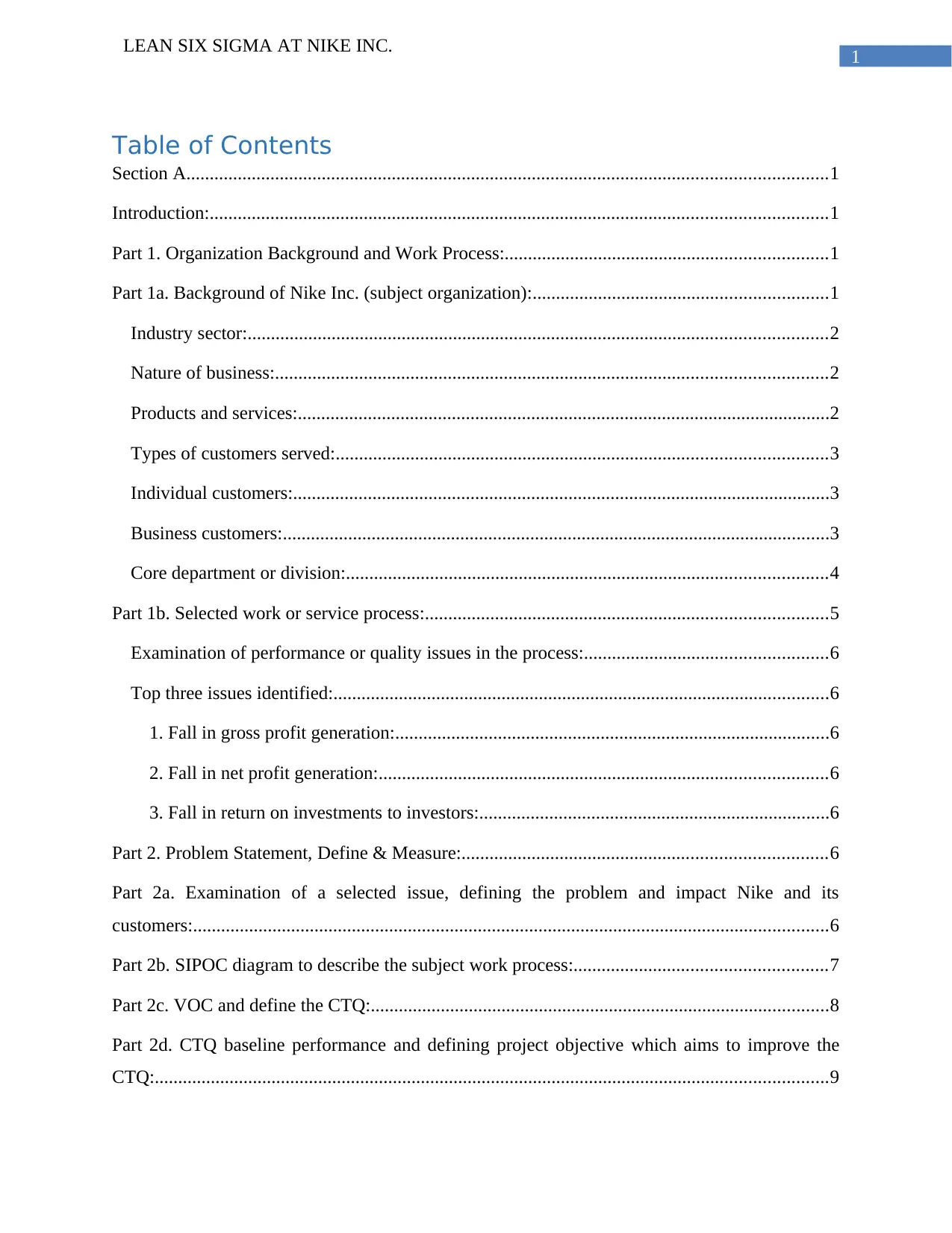
1
LEAN SIX SIGMA AT NIKE INC.
Table of Contents
Section A.........................................................................................................................................1
Introduction:....................................................................................................................................1
Part 1. Organization Background and Work Process:.....................................................................1
Part 1a. Background of Nike Inc. (subject organization):...............................................................1
Industry sector:............................................................................................................................2
Nature of business:......................................................................................................................2
Products and services:..................................................................................................................2
Types of customers served:.........................................................................................................3
Individual customers:...................................................................................................................3
Business customers:.....................................................................................................................3
Core department or division:.......................................................................................................4
Part 1b. Selected work or service process:......................................................................................5
Examination of performance or quality issues in the process:....................................................6
Top three issues identified:..........................................................................................................6
1. Fall in gross profit generation:.............................................................................................6
2. Fall in net profit generation:................................................................................................6
3. Fall in return on investments to investors:...........................................................................6
Part 2. Problem Statement, Define & Measure:..............................................................................6
Part 2a. Examination of a selected issue, defining the problem and impact Nike and its
customers:........................................................................................................................................6
Part 2b. SIPOC diagram to describe the subject work process:......................................................7
Part 2c. VOC and define the CTQ:..................................................................................................8
Part 2d. CTQ baseline performance and defining project objective which aims to improve the
CTQ:................................................................................................................................................9
LEAN SIX SIGMA AT NIKE INC.
Table of Contents
Section A.........................................................................................................................................1
Introduction:....................................................................................................................................1
Part 1. Organization Background and Work Process:.....................................................................1
Part 1a. Background of Nike Inc. (subject organization):...............................................................1
Industry sector:............................................................................................................................2
Nature of business:......................................................................................................................2
Products and services:..................................................................................................................2
Types of customers served:.........................................................................................................3
Individual customers:...................................................................................................................3
Business customers:.....................................................................................................................3
Core department or division:.......................................................................................................4
Part 1b. Selected work or service process:......................................................................................5
Examination of performance or quality issues in the process:....................................................6
Top three issues identified:..........................................................................................................6
1. Fall in gross profit generation:.............................................................................................6
2. Fall in net profit generation:................................................................................................6
3. Fall in return on investments to investors:...........................................................................6
Part 2. Problem Statement, Define & Measure:..............................................................................6
Part 2a. Examination of a selected issue, defining the problem and impact Nike and its
customers:........................................................................................................................................6
Part 2b. SIPOC diagram to describe the subject work process:......................................................7
Part 2c. VOC and define the CTQ:..................................................................................................8
Part 2d. CTQ baseline performance and defining project objective which aims to improve the
CTQ:................................................................................................................................................9
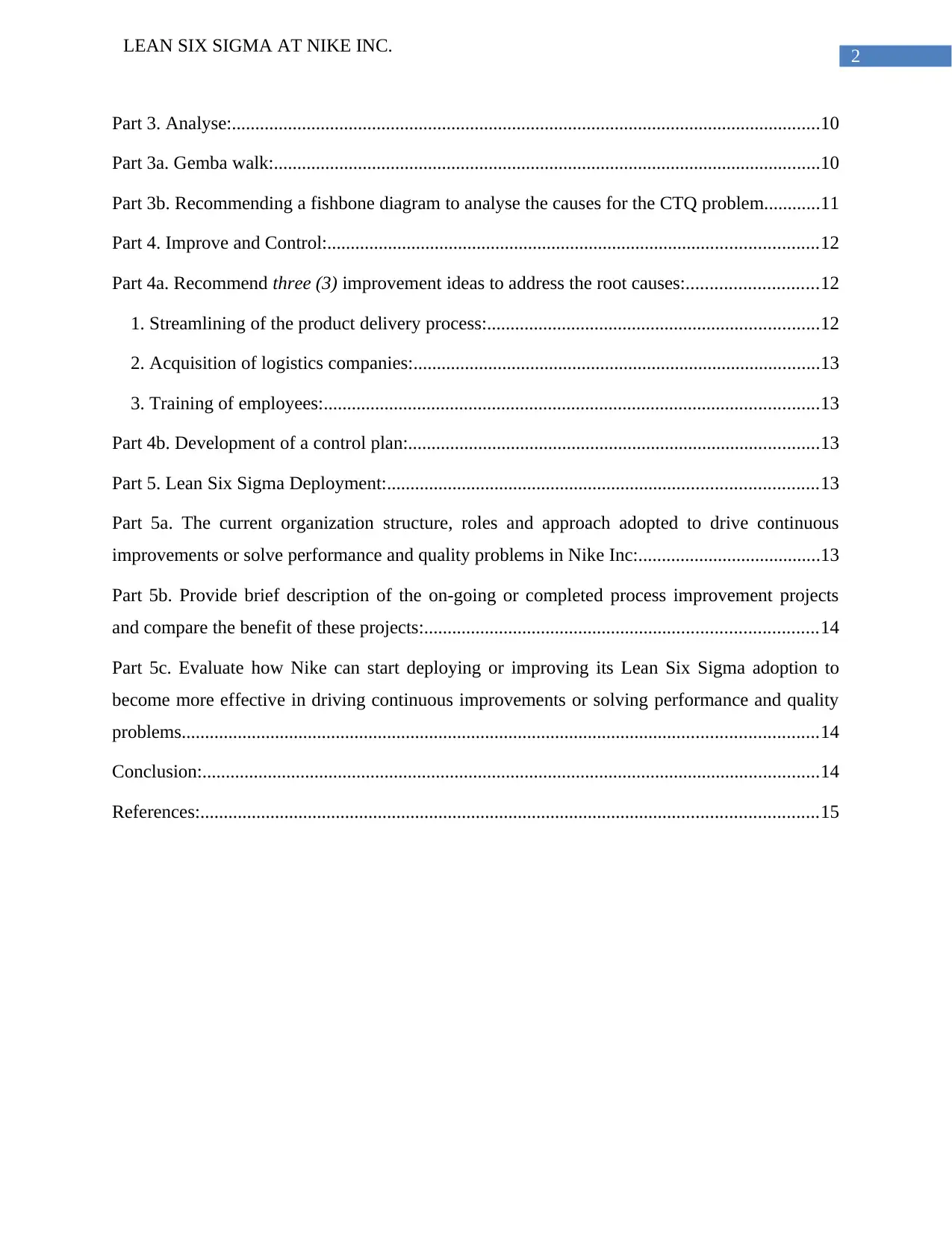
2
LEAN SIX SIGMA AT NIKE INC.
Part 3. Analyse:..............................................................................................................................10
Part 3a. Gemba walk:.....................................................................................................................10
Part 3b. Recommending a fishbone diagram to analyse the causes for the CTQ problem............11
Part 4. Improve and Control:.........................................................................................................12
Part 4a. Recommend three (3) improvement ideas to address the root causes:............................12
1. Streamlining of the product delivery process:.......................................................................12
2. Acquisition of logistics companies:.......................................................................................13
3. Training of employees:..........................................................................................................13
Part 4b. Development of a control plan:........................................................................................13
Part 5. Lean Six Sigma Deployment:............................................................................................13
Part 5a. The current organization structure, roles and approach adopted to drive continuous
improvements or solve performance and quality problems in Nike Inc:.......................................13
Part 5b. Provide brief description of the on-going or completed process improvement projects
and compare the benefit of these projects:....................................................................................14
Part 5c. Evaluate how Nike can start deploying or improving its Lean Six Sigma adoption to
become more effective in driving continuous improvements or solving performance and quality
problems........................................................................................................................................14
Conclusion:....................................................................................................................................14
References:....................................................................................................................................15
LEAN SIX SIGMA AT NIKE INC.
Part 3. Analyse:..............................................................................................................................10
Part 3a. Gemba walk:.....................................................................................................................10
Part 3b. Recommending a fishbone diagram to analyse the causes for the CTQ problem............11
Part 4. Improve and Control:.........................................................................................................12
Part 4a. Recommend three (3) improvement ideas to address the root causes:............................12
1. Streamlining of the product delivery process:.......................................................................12
2. Acquisition of logistics companies:.......................................................................................13
3. Training of employees:..........................................................................................................13
Part 4b. Development of a control plan:........................................................................................13
Part 5. Lean Six Sigma Deployment:............................................................................................13
Part 5a. The current organization structure, roles and approach adopted to drive continuous
improvements or solve performance and quality problems in Nike Inc:.......................................13
Part 5b. Provide brief description of the on-going or completed process improvement projects
and compare the benefit of these projects:....................................................................................14
Part 5c. Evaluate how Nike can start deploying or improving its Lean Six Sigma adoption to
become more effective in driving continuous improvements or solving performance and quality
problems........................................................................................................................................14
Conclusion:....................................................................................................................................14
References:....................................................................................................................................15
⊘ This is a preview!⊘
Do you want full access?
Subscribe today to unlock all pages.

Trusted by 1+ million students worldwide
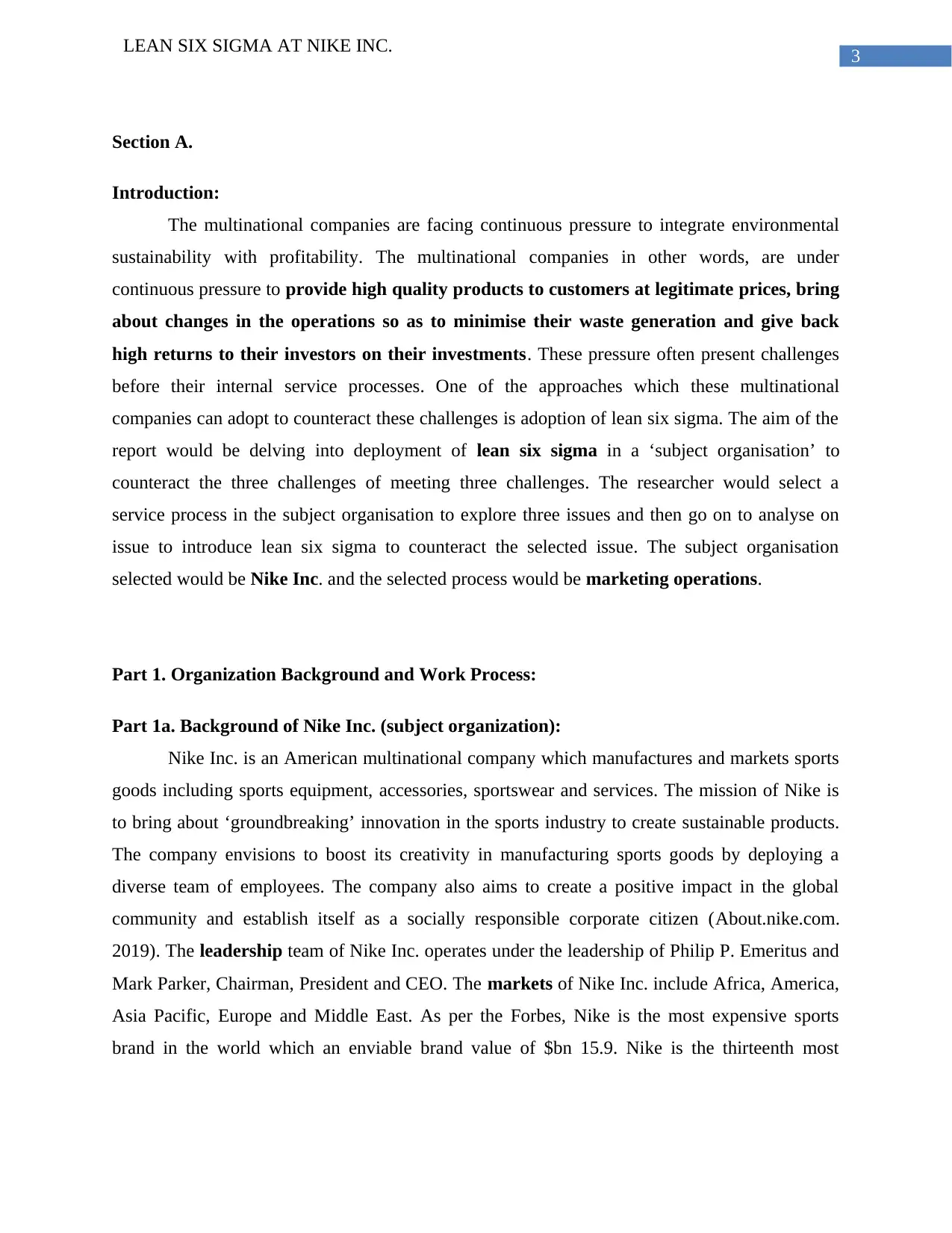
3
LEAN SIX SIGMA AT NIKE INC.
Section A.
Introduction:
The multinational companies are facing continuous pressure to integrate environmental
sustainability with profitability. The multinational companies in other words, are under
continuous pressure to provide high quality products to customers at legitimate prices, bring
about changes in the operations so as to minimise their waste generation and give back
high returns to their investors on their investments. These pressure often present challenges
before their internal service processes. One of the approaches which these multinational
companies can adopt to counteract these challenges is adoption of lean six sigma. The aim of the
report would be delving into deployment of lean six sigma in a ‘subject organisation’ to
counteract the three challenges of meeting three challenges. The researcher would select a
service process in the subject organisation to explore three issues and then go on to analyse on
issue to introduce lean six sigma to counteract the selected issue. The subject organisation
selected would be Nike Inc. and the selected process would be marketing operations.
Part 1. Organization Background and Work Process:
Part 1a. Background of Nike Inc. (subject organization):
Nike Inc. is an American multinational company which manufactures and markets sports
goods including sports equipment, accessories, sportswear and services. The mission of Nike is
to bring about ‘groundbreaking’ innovation in the sports industry to create sustainable products.
The company envisions to boost its creativity in manufacturing sports goods by deploying a
diverse team of employees. The company also aims to create a positive impact in the global
community and establish itself as a socially responsible corporate citizen (About.nike.com.
2019). The leadership team of Nike Inc. operates under the leadership of Philip P. Emeritus and
Mark Parker, Chairman, President and CEO. The markets of Nike Inc. include Africa, America,
Asia Pacific, Europe and Middle East. As per the Forbes, Nike is the most expensive sports
brand in the world which an enviable brand value of $bn 15.9. Nike is the thirteenth most
LEAN SIX SIGMA AT NIKE INC.
Section A.
Introduction:
The multinational companies are facing continuous pressure to integrate environmental
sustainability with profitability. The multinational companies in other words, are under
continuous pressure to provide high quality products to customers at legitimate prices, bring
about changes in the operations so as to minimise their waste generation and give back
high returns to their investors on their investments. These pressure often present challenges
before their internal service processes. One of the approaches which these multinational
companies can adopt to counteract these challenges is adoption of lean six sigma. The aim of the
report would be delving into deployment of lean six sigma in a ‘subject organisation’ to
counteract the three challenges of meeting three challenges. The researcher would select a
service process in the subject organisation to explore three issues and then go on to analyse on
issue to introduce lean six sigma to counteract the selected issue. The subject organisation
selected would be Nike Inc. and the selected process would be marketing operations.
Part 1. Organization Background and Work Process:
Part 1a. Background of Nike Inc. (subject organization):
Nike Inc. is an American multinational company which manufactures and markets sports
goods including sports equipment, accessories, sportswear and services. The mission of Nike is
to bring about ‘groundbreaking’ innovation in the sports industry to create sustainable products.
The company envisions to boost its creativity in manufacturing sports goods by deploying a
diverse team of employees. The company also aims to create a positive impact in the global
community and establish itself as a socially responsible corporate citizen (About.nike.com.
2019). The leadership team of Nike Inc. operates under the leadership of Philip P. Emeritus and
Mark Parker, Chairman, President and CEO. The markets of Nike Inc. include Africa, America,
Asia Pacific, Europe and Middle East. As per the Forbes, Nike is the most expensive sports
brand in the world which an enviable brand value of $bn 15.9. Nike is the thirteenth most
Paraphrase This Document
Need a fresh take? Get an instant paraphrase of this document with our AI Paraphraser
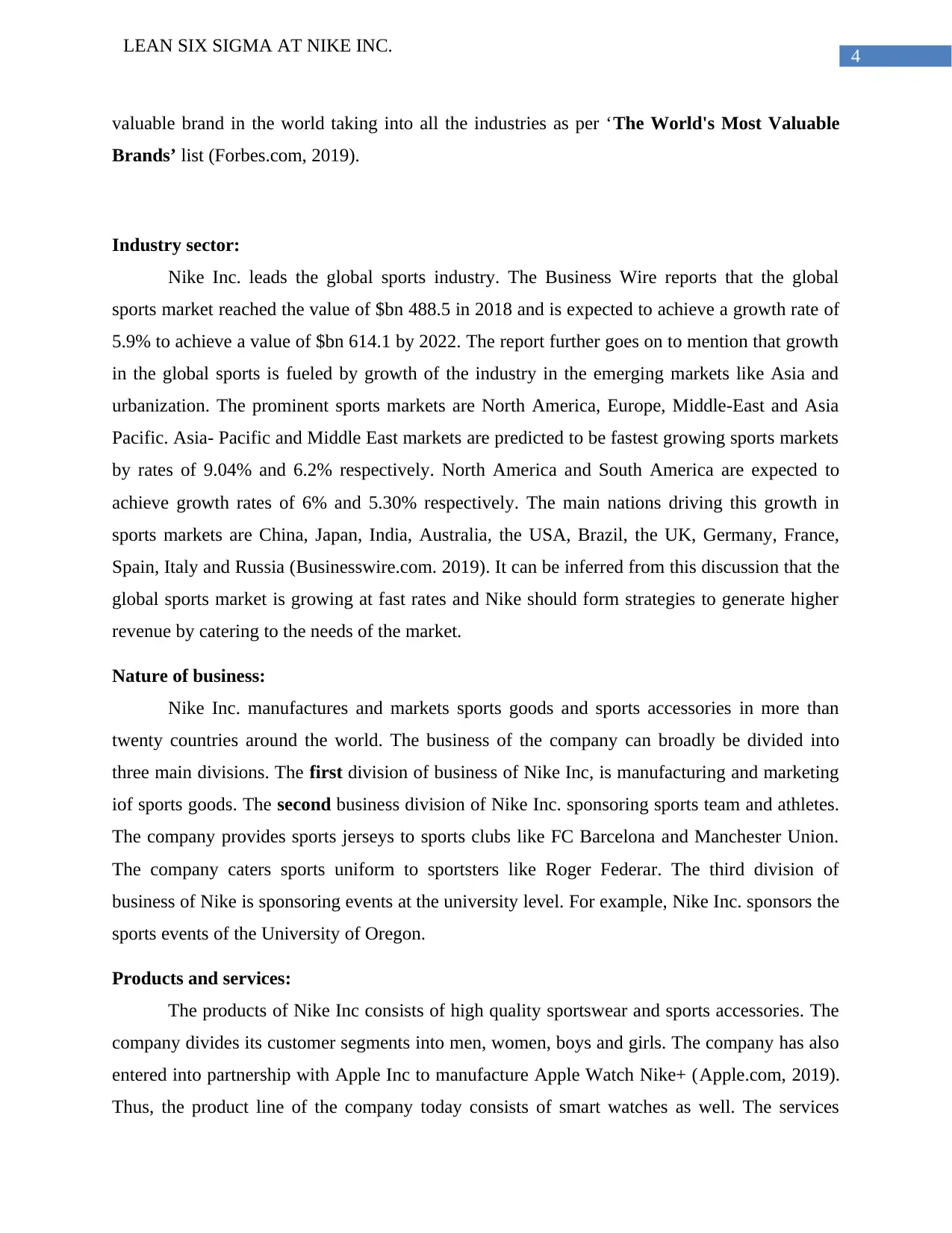
4
LEAN SIX SIGMA AT NIKE INC.
valuable brand in the world taking into all the industries as per ‘The World's Most Valuable
Brands’ list (Forbes.com, 2019).
Industry sector:
Nike Inc. leads the global sports industry. The Business Wire reports that the global
sports market reached the value of $bn 488.5 in 2018 and is expected to achieve a growth rate of
5.9% to achieve a value of $bn 614.1 by 2022. The report further goes on to mention that growth
in the global sports is fueled by growth of the industry in the emerging markets like Asia and
urbanization. The prominent sports markets are North America, Europe, Middle-East and Asia
Pacific. Asia- Pacific and Middle East markets are predicted to be fastest growing sports markets
by rates of 9.04% and 6.2% respectively. North America and South America are expected to
achieve growth rates of 6% and 5.30% respectively. The main nations driving this growth in
sports markets are China, Japan, India, Australia, the USA, Brazil, the UK, Germany, France,
Spain, Italy and Russia (Businesswire.com. 2019). It can be inferred from this discussion that the
global sports market is growing at fast rates and Nike should form strategies to generate higher
revenue by catering to the needs of the market.
Nature of business:
Nike Inc. manufactures and markets sports goods and sports accessories in more than
twenty countries around the world. The business of the company can broadly be divided into
three main divisions. The first division of business of Nike Inc, is manufacturing and marketing
iof sports goods. The second business division of Nike Inc. sponsoring sports team and athletes.
The company provides sports jerseys to sports clubs like FC Barcelona and Manchester Union.
The company caters sports uniform to sportsters like Roger Federar. The third division of
business of Nike is sponsoring events at the university level. For example, Nike Inc. sponsors the
sports events of the University of Oregon.
Products and services:
The products of Nike Inc consists of high quality sportswear and sports accessories. The
company divides its customer segments into men, women, boys and girls. The company has also
entered into partnership with Apple Inc to manufacture Apple Watch Nike+ (Apple.com, 2019).
Thus, the product line of the company today consists of smart watches as well. The services
LEAN SIX SIGMA AT NIKE INC.
valuable brand in the world taking into all the industries as per ‘The World's Most Valuable
Brands’ list (Forbes.com, 2019).
Industry sector:
Nike Inc. leads the global sports industry. The Business Wire reports that the global
sports market reached the value of $bn 488.5 in 2018 and is expected to achieve a growth rate of
5.9% to achieve a value of $bn 614.1 by 2022. The report further goes on to mention that growth
in the global sports is fueled by growth of the industry in the emerging markets like Asia and
urbanization. The prominent sports markets are North America, Europe, Middle-East and Asia
Pacific. Asia- Pacific and Middle East markets are predicted to be fastest growing sports markets
by rates of 9.04% and 6.2% respectively. North America and South America are expected to
achieve growth rates of 6% and 5.30% respectively. The main nations driving this growth in
sports markets are China, Japan, India, Australia, the USA, Brazil, the UK, Germany, France,
Spain, Italy and Russia (Businesswire.com. 2019). It can be inferred from this discussion that the
global sports market is growing at fast rates and Nike should form strategies to generate higher
revenue by catering to the needs of the market.
Nature of business:
Nike Inc. manufactures and markets sports goods and sports accessories in more than
twenty countries around the world. The business of the company can broadly be divided into
three main divisions. The first division of business of Nike Inc, is manufacturing and marketing
iof sports goods. The second business division of Nike Inc. sponsoring sports team and athletes.
The company provides sports jerseys to sports clubs like FC Barcelona and Manchester Union.
The company caters sports uniform to sportsters like Roger Federar. The third division of
business of Nike is sponsoring events at the university level. For example, Nike Inc. sponsors the
sports events of the University of Oregon.
Products and services:
The products of Nike Inc consists of high quality sportswear and sports accessories. The
company divides its customer segments into men, women, boys and girls. The company has also
entered into partnership with Apple Inc to manufacture Apple Watch Nike+ (Apple.com, 2019).
Thus, the product line of the company today consists of smart watches as well. The services
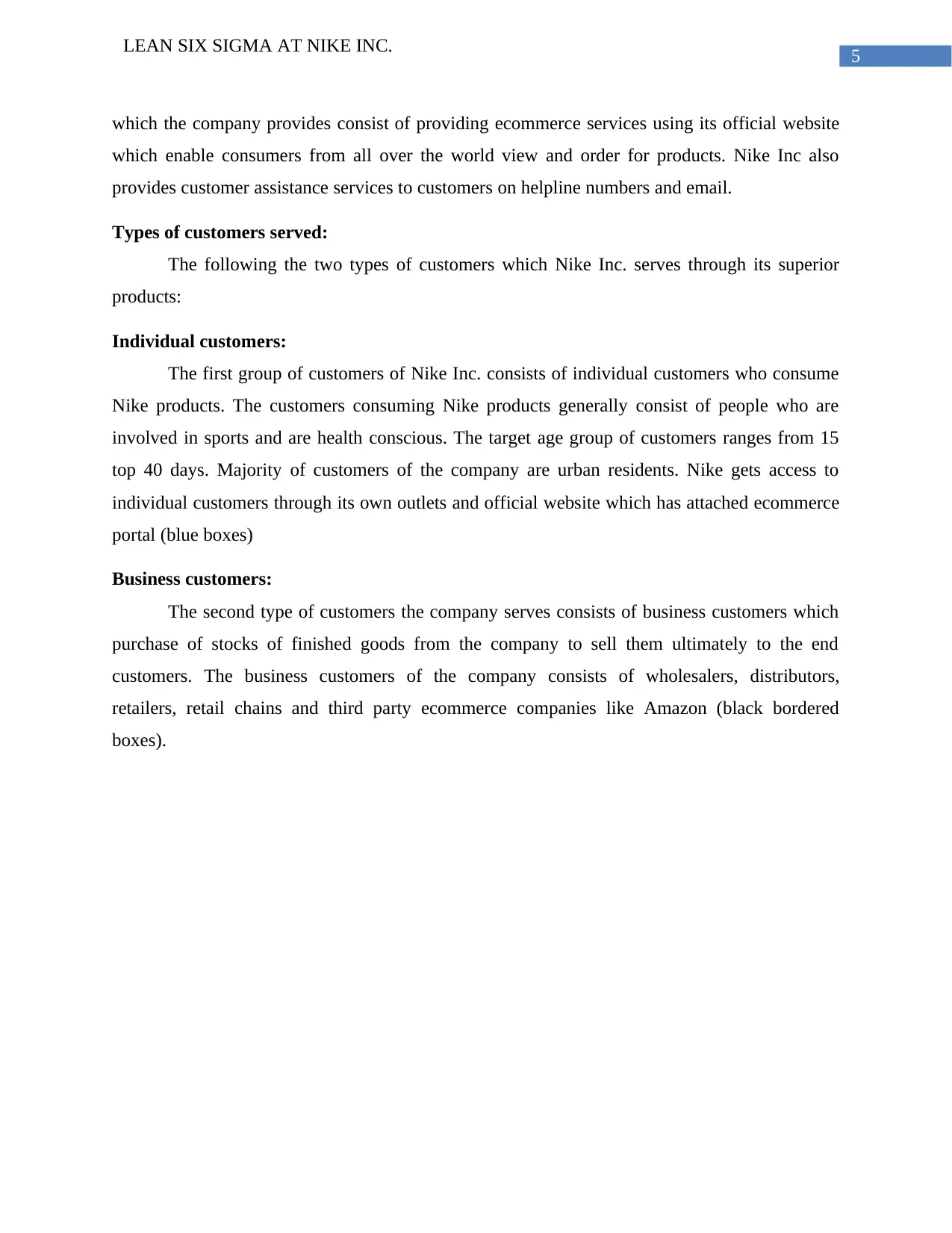
5
LEAN SIX SIGMA AT NIKE INC.
which the company provides consist of providing ecommerce services using its official website
which enable consumers from all over the world view and order for products. Nike Inc also
provides customer assistance services to customers on helpline numbers and email.
Types of customers served:
The following the two types of customers which Nike Inc. serves through its superior
products:
Individual customers:
The first group of customers of Nike Inc. consists of individual customers who consume
Nike products. The customers consuming Nike products generally consist of people who are
involved in sports and are health conscious. The target age group of customers ranges from 15
top 40 days. Majority of customers of the company are urban residents. Nike gets access to
individual customers through its own outlets and official website which has attached ecommerce
portal (blue boxes)
Business customers:
The second type of customers the company serves consists of business customers which
purchase of stocks of finished goods from the company to sell them ultimately to the end
customers. The business customers of the company consists of wholesalers, distributors,
retailers, retail chains and third party ecommerce companies like Amazon (black bordered
boxes).
LEAN SIX SIGMA AT NIKE INC.
which the company provides consist of providing ecommerce services using its official website
which enable consumers from all over the world view and order for products. Nike Inc also
provides customer assistance services to customers on helpline numbers and email.
Types of customers served:
The following the two types of customers which Nike Inc. serves through its superior
products:
Individual customers:
The first group of customers of Nike Inc. consists of individual customers who consume
Nike products. The customers consuming Nike products generally consist of people who are
involved in sports and are health conscious. The target age group of customers ranges from 15
top 40 days. Majority of customers of the company are urban residents. Nike gets access to
individual customers through its own outlets and official website which has attached ecommerce
portal (blue boxes)
Business customers:
The second type of customers the company serves consists of business customers which
purchase of stocks of finished goods from the company to sell them ultimately to the end
customers. The business customers of the company consists of wholesalers, distributors,
retailers, retail chains and third party ecommerce companies like Amazon (black bordered
boxes).
⊘ This is a preview!⊘
Do you want full access?
Subscribe today to unlock all pages.

Trusted by 1+ million students worldwide
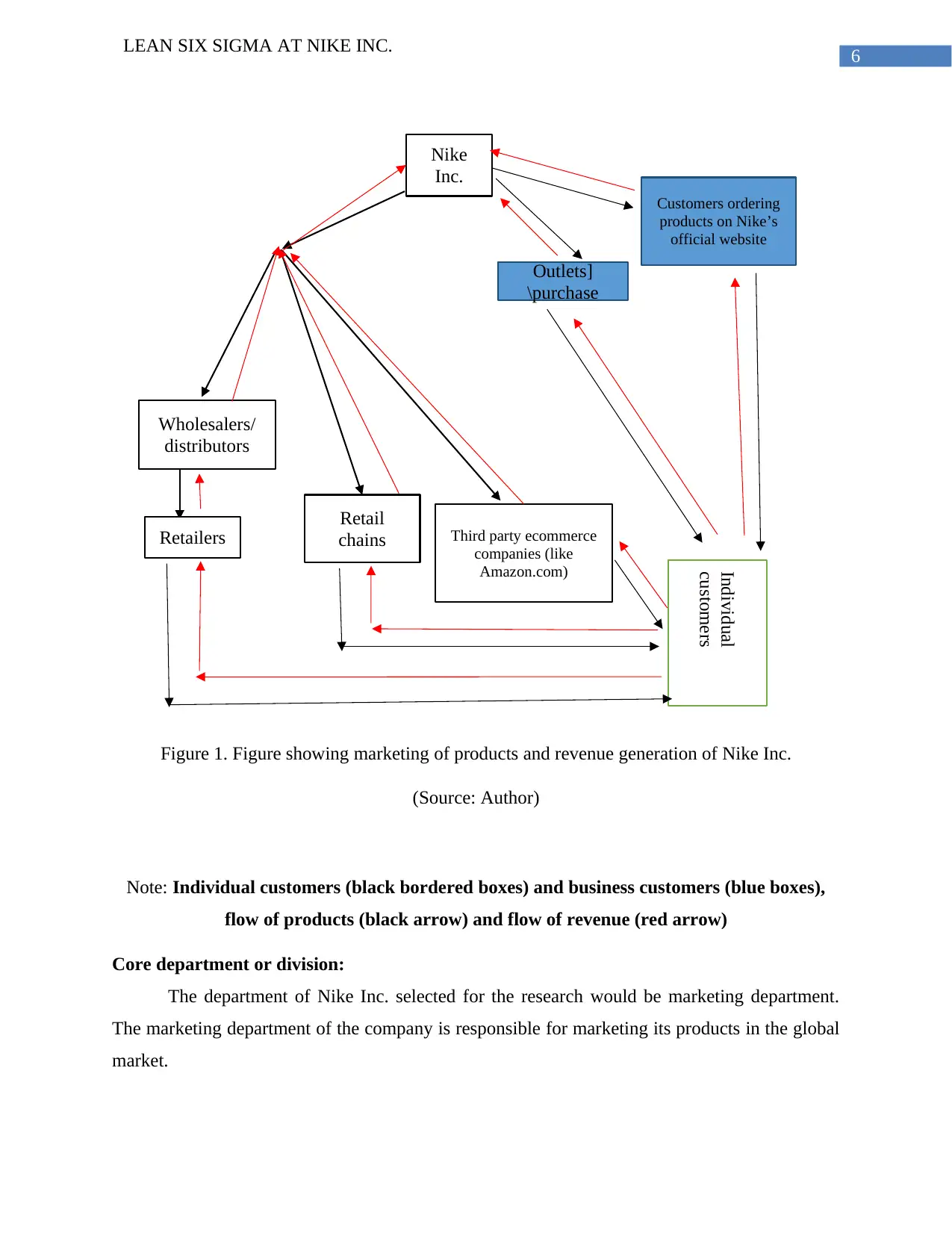
6
LEAN SIX SIGMA AT NIKE INC.
Nike
Inc.
Wholesalers/
distributors
Retailers
Retail
chains Third party ecommerce
companies (like
Amazon.com)
Outlets]
\purchase
Customers ordering
products on Nike’s
official website
Individual
customers
Figure 1. Figure showing marketing of products and revenue generation of Nike Inc.
(Source: Author)
Note: Individual customers (black bordered boxes) and business customers (blue boxes),
flow of products (black arrow) and flow of revenue (red arrow)
Core department or division:
The department of Nike Inc. selected for the research would be marketing department.
The marketing department of the company is responsible for marketing its products in the global
market.
LEAN SIX SIGMA AT NIKE INC.
Nike
Inc.
Wholesalers/
distributors
Retailers
Retail
chains Third party ecommerce
companies (like
Amazon.com)
Outlets]
\purchase
Customers ordering
products on Nike’s
official website
Individual
customers
Figure 1. Figure showing marketing of products and revenue generation of Nike Inc.
(Source: Author)
Note: Individual customers (black bordered boxes) and business customers (blue boxes),
flow of products (black arrow) and flow of revenue (red arrow)
Core department or division:
The department of Nike Inc. selected for the research would be marketing department.
The marketing department of the company is responsible for marketing its products in the global
market.
Paraphrase This Document
Need a fresh take? Get an instant paraphrase of this document with our AI Paraphraser
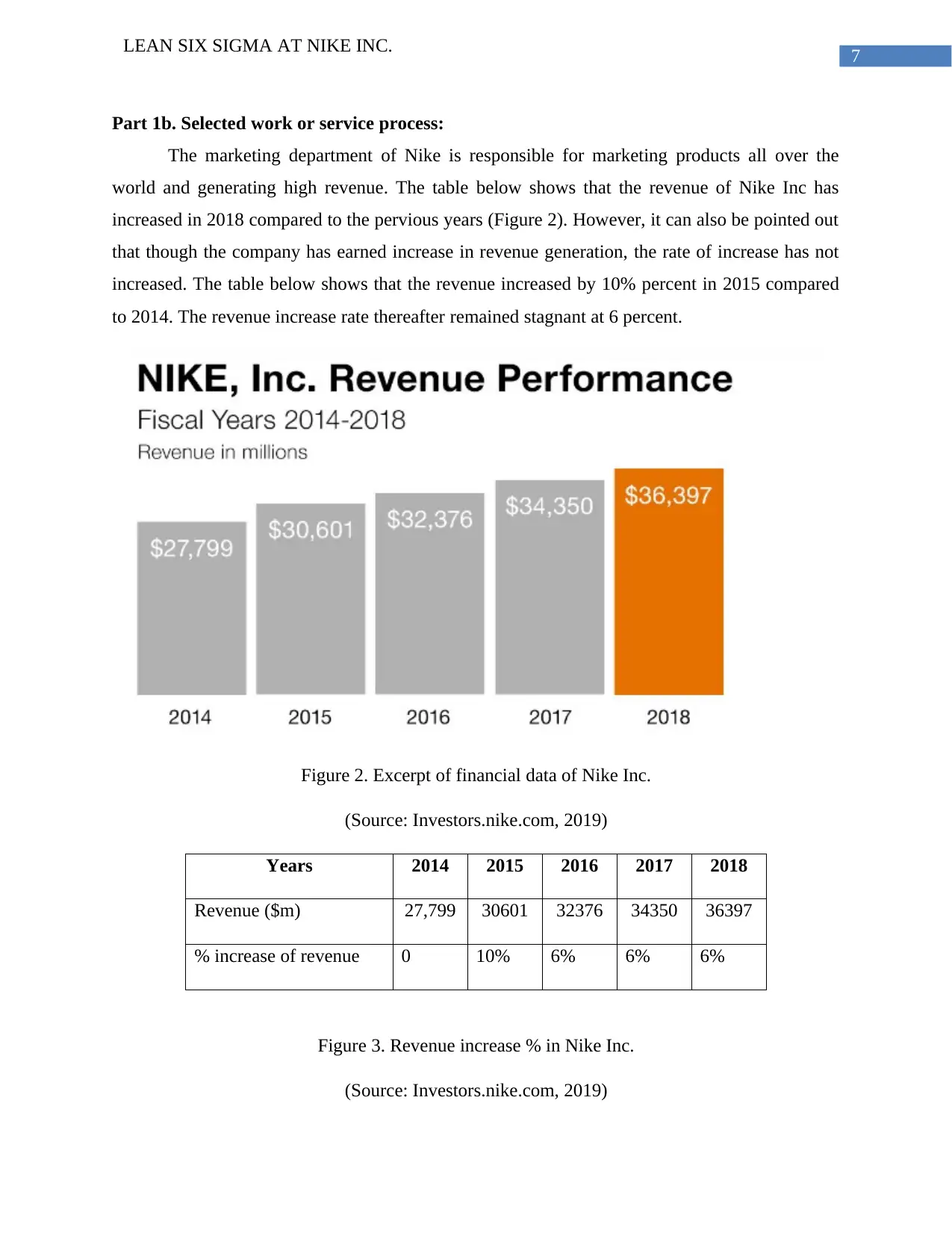
7
LEAN SIX SIGMA AT NIKE INC.
Part 1b. Selected work or service process:
The marketing department of Nike is responsible for marketing products all over the
world and generating high revenue. The table below shows that the revenue of Nike Inc has
increased in 2018 compared to the pervious years (Figure 2). However, it can also be pointed out
that though the company has earned increase in revenue generation, the rate of increase has not
increased. The table below shows that the revenue increased by 10% percent in 2015 compared
to 2014. The revenue increase rate thereafter remained stagnant at 6 percent.
Figure 2. Excerpt of financial data of Nike Inc.
(Source: Investors.nike.com, 2019)
Years 2014 2015 2016 2017 2018
Revenue ($m) 27,799 30601 32376 34350 36397
% increase of revenue 0 10% 6% 6% 6%
Figure 3. Revenue increase % in Nike Inc.
(Source: Investors.nike.com, 2019)
LEAN SIX SIGMA AT NIKE INC.
Part 1b. Selected work or service process:
The marketing department of Nike is responsible for marketing products all over the
world and generating high revenue. The table below shows that the revenue of Nike Inc has
increased in 2018 compared to the pervious years (Figure 2). However, it can also be pointed out
that though the company has earned increase in revenue generation, the rate of increase has not
increased. The table below shows that the revenue increased by 10% percent in 2015 compared
to 2014. The revenue increase rate thereafter remained stagnant at 6 percent.
Figure 2. Excerpt of financial data of Nike Inc.
(Source: Investors.nike.com, 2019)
Years 2014 2015 2016 2017 2018
Revenue ($m) 27,799 30601 32376 34350 36397
% increase of revenue 0 10% 6% 6% 6%
Figure 3. Revenue increase % in Nike Inc.
(Source: Investors.nike.com, 2019)
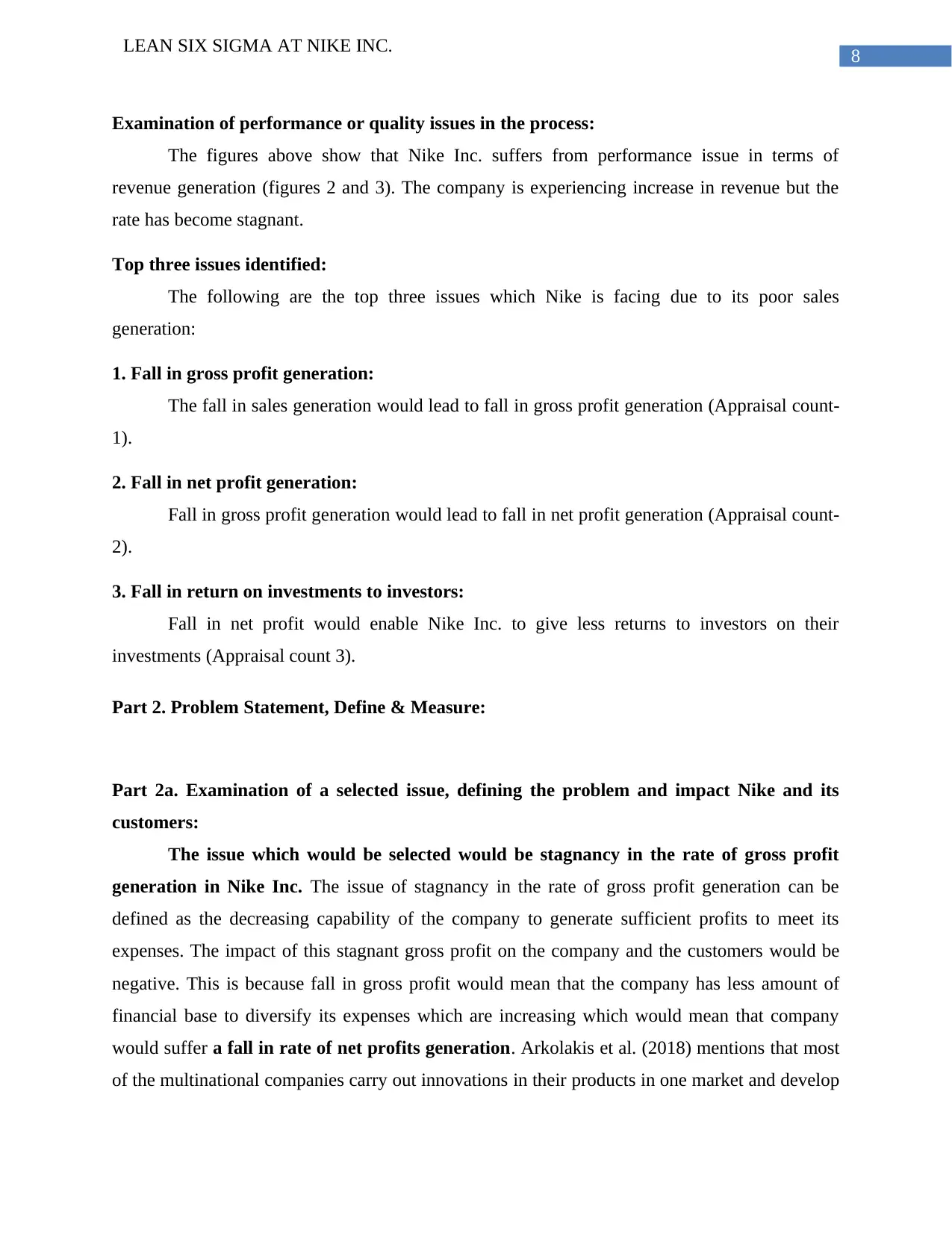
8
LEAN SIX SIGMA AT NIKE INC.
Examination of performance or quality issues in the process:
The figures above show that Nike Inc. suffers from performance issue in terms of
revenue generation (figures 2 and 3). The company is experiencing increase in revenue but the
rate has become stagnant.
Top three issues identified:
The following are the top three issues which Nike is facing due to its poor sales
generation:
1. Fall in gross profit generation:
The fall in sales generation would lead to fall in gross profit generation (Appraisal count-
1).
2. Fall in net profit generation:
Fall in gross profit generation would lead to fall in net profit generation (Appraisal count-
2).
3. Fall in return on investments to investors:
Fall in net profit would enable Nike Inc. to give less returns to investors on their
investments (Appraisal count 3).
Part 2. Problem Statement, Define & Measure:
Part 2a. Examination of a selected issue, defining the problem and impact Nike and its
customers:
The issue which would be selected would be stagnancy in the rate of gross profit
generation in Nike Inc. The issue of stagnancy in the rate of gross profit generation can be
defined as the decreasing capability of the company to generate sufficient profits to meet its
expenses. The impact of this stagnant gross profit on the company and the customers would be
negative. This is because fall in gross profit would mean that the company has less amount of
financial base to diversify its expenses which are increasing which would mean that company
would suffer a fall in rate of net profits generation. Arkolakis et al. (2018) mentions that most
of the multinational companies carry out innovations in their products in one market and develop
LEAN SIX SIGMA AT NIKE INC.
Examination of performance or quality issues in the process:
The figures above show that Nike Inc. suffers from performance issue in terms of
revenue generation (figures 2 and 3). The company is experiencing increase in revenue but the
rate has become stagnant.
Top three issues identified:
The following are the top three issues which Nike is facing due to its poor sales
generation:
1. Fall in gross profit generation:
The fall in sales generation would lead to fall in gross profit generation (Appraisal count-
1).
2. Fall in net profit generation:
Fall in gross profit generation would lead to fall in net profit generation (Appraisal count-
2).
3. Fall in return on investments to investors:
Fall in net profit would enable Nike Inc. to give less returns to investors on their
investments (Appraisal count 3).
Part 2. Problem Statement, Define & Measure:
Part 2a. Examination of a selected issue, defining the problem and impact Nike and its
customers:
The issue which would be selected would be stagnancy in the rate of gross profit
generation in Nike Inc. The issue of stagnancy in the rate of gross profit generation can be
defined as the decreasing capability of the company to generate sufficient profits to meet its
expenses. The impact of this stagnant gross profit on the company and the customers would be
negative. This is because fall in gross profit would mean that the company has less amount of
financial base to diversify its expenses which are increasing which would mean that company
would suffer a fall in rate of net profits generation. Arkolakis et al. (2018) mentions that most
of the multinational companies carry out innovations in their products in one market and develop
⊘ This is a preview!⊘
Do you want full access?
Subscribe today to unlock all pages.

Trusted by 1+ million students worldwide
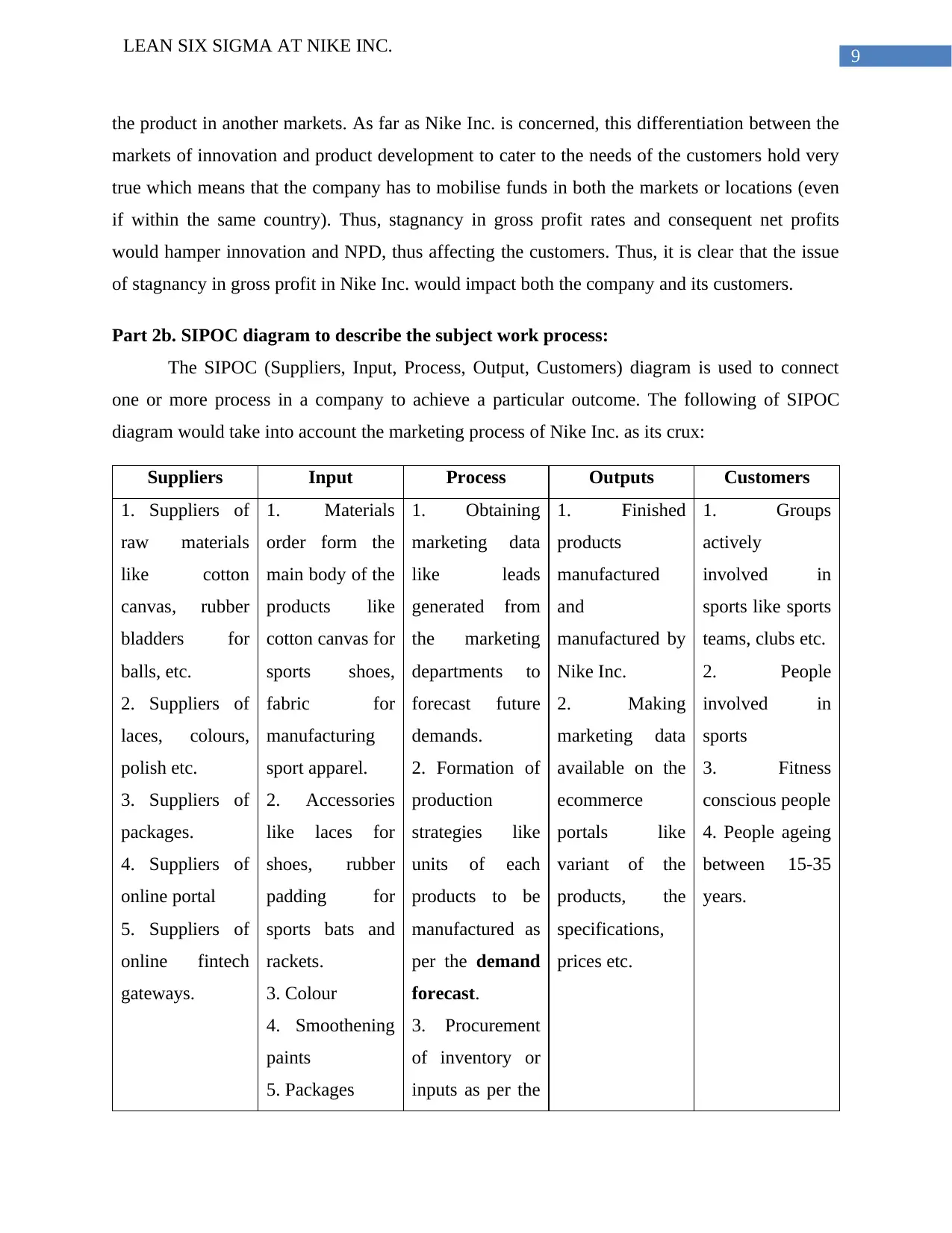
9
LEAN SIX SIGMA AT NIKE INC.
the product in another markets. As far as Nike Inc. is concerned, this differentiation between the
markets of innovation and product development to cater to the needs of the customers hold very
true which means that the company has to mobilise funds in both the markets or locations (even
if within the same country). Thus, stagnancy in gross profit rates and consequent net profits
would hamper innovation and NPD, thus affecting the customers. Thus, it is clear that the issue
of stagnancy in gross profit in Nike Inc. would impact both the company and its customers.
Part 2b. SIPOC diagram to describe the subject work process:
The SIPOC (Suppliers, Input, Process, Output, Customers) diagram is used to connect
one or more process in a company to achieve a particular outcome. The following of SIPOC
diagram would take into account the marketing process of Nike Inc. as its crux:
Suppliers Input Process Outputs Customers
1. Suppliers of
raw materials
like cotton
canvas, rubber
bladders for
balls, etc.
2. Suppliers of
laces, colours,
polish etc.
3. Suppliers of
packages.
4. Suppliers of
online portal
5. Suppliers of
online fintech
gateways.
1. Materials
order form the
main body of the
products like
cotton canvas for
sports shoes,
fabric for
manufacturing
sport apparel.
2. Accessories
like laces for
shoes, rubber
padding for
sports bats and
rackets.
3. Colour
4. Smoothening
paints
5. Packages
1. Obtaining
marketing data
like leads
generated from
the marketing
departments to
forecast future
demands.
2. Formation of
production
strategies like
units of each
products to be
manufactured as
per the demand
forecast.
3. Procurement
of inventory or
inputs as per the
1. Finished
products
manufactured
and
manufactured by
Nike Inc.
2. Making
marketing data
available on the
ecommerce
portals like
variant of the
products, the
specifications,
prices etc.
1. Groups
actively
involved in
sports like sports
teams, clubs etc.
2. People
involved in
sports
3. Fitness
conscious people
4. People ageing
between 15-35
years.
LEAN SIX SIGMA AT NIKE INC.
the product in another markets. As far as Nike Inc. is concerned, this differentiation between the
markets of innovation and product development to cater to the needs of the customers hold very
true which means that the company has to mobilise funds in both the markets or locations (even
if within the same country). Thus, stagnancy in gross profit rates and consequent net profits
would hamper innovation and NPD, thus affecting the customers. Thus, it is clear that the issue
of stagnancy in gross profit in Nike Inc. would impact both the company and its customers.
Part 2b. SIPOC diagram to describe the subject work process:
The SIPOC (Suppliers, Input, Process, Output, Customers) diagram is used to connect
one or more process in a company to achieve a particular outcome. The following of SIPOC
diagram would take into account the marketing process of Nike Inc. as its crux:
Suppliers Input Process Outputs Customers
1. Suppliers of
raw materials
like cotton
canvas, rubber
bladders for
balls, etc.
2. Suppliers of
laces, colours,
polish etc.
3. Suppliers of
packages.
4. Suppliers of
online portal
5. Suppliers of
online fintech
gateways.
1. Materials
order form the
main body of the
products like
cotton canvas for
sports shoes,
fabric for
manufacturing
sport apparel.
2. Accessories
like laces for
shoes, rubber
padding for
sports bats and
rackets.
3. Colour
4. Smoothening
paints
5. Packages
1. Obtaining
marketing data
like leads
generated from
the marketing
departments to
forecast future
demands.
2. Formation of
production
strategies like
units of each
products to be
manufactured as
per the demand
forecast.
3. Procurement
of inventory or
inputs as per the
1. Finished
products
manufactured
and
manufactured by
Nike Inc.
2. Making
marketing data
available on the
ecommerce
portals like
variant of the
products, the
specifications,
prices etc.
1. Groups
actively
involved in
sports like sports
teams, clubs etc.
2. People
involved in
sports
3. Fitness
conscious people
4. People ageing
between 15-35
years.
Paraphrase This Document
Need a fresh take? Get an instant paraphrase of this document with our AI Paraphraser
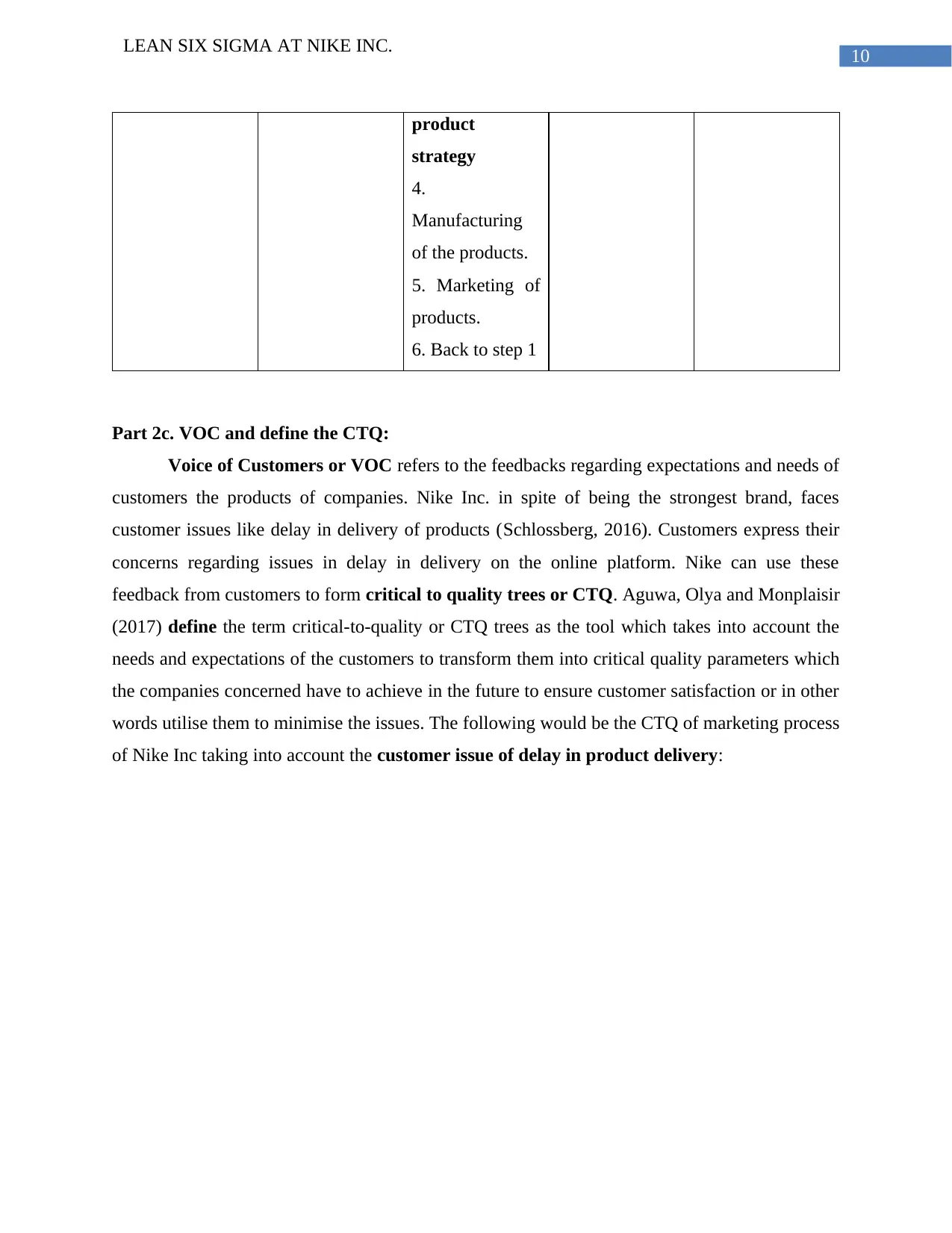
10
LEAN SIX SIGMA AT NIKE INC.
product
strategy
4.
Manufacturing
of the products.
5. Marketing of
products.
6. Back to step 1
Part 2c. VOC and define the CTQ:
Voice of Customers or VOC refers to the feedbacks regarding expectations and needs of
customers the products of companies. Nike Inc. in spite of being the strongest brand, faces
customer issues like delay in delivery of products (Schlossberg, 2016). Customers express their
concerns regarding issues in delay in delivery on the online platform. Nike can use these
feedback from customers to form critical to quality trees or CTQ. Aguwa, Olya and Monplaisir
(2017) define the term critical-to-quality or CTQ trees as the tool which takes into account the
needs and expectations of the customers to transform them into critical quality parameters which
the companies concerned have to achieve in the future to ensure customer satisfaction or in other
words utilise them to minimise the issues. The following would be the CTQ of marketing process
of Nike Inc taking into account the customer issue of delay in product delivery:
LEAN SIX SIGMA AT NIKE INC.
product
strategy
4.
Manufacturing
of the products.
5. Marketing of
products.
6. Back to step 1
Part 2c. VOC and define the CTQ:
Voice of Customers or VOC refers to the feedbacks regarding expectations and needs of
customers the products of companies. Nike Inc. in spite of being the strongest brand, faces
customer issues like delay in delivery of products (Schlossberg, 2016). Customers express their
concerns regarding issues in delay in delivery on the online platform. Nike can use these
feedback from customers to form critical to quality trees or CTQ. Aguwa, Olya and Monplaisir
(2017) define the term critical-to-quality or CTQ trees as the tool which takes into account the
needs and expectations of the customers to transform them into critical quality parameters which
the companies concerned have to achieve in the future to ensure customer satisfaction or in other
words utilise them to minimise the issues. The following would be the CTQ of marketing process
of Nike Inc taking into account the customer issue of delay in product delivery:
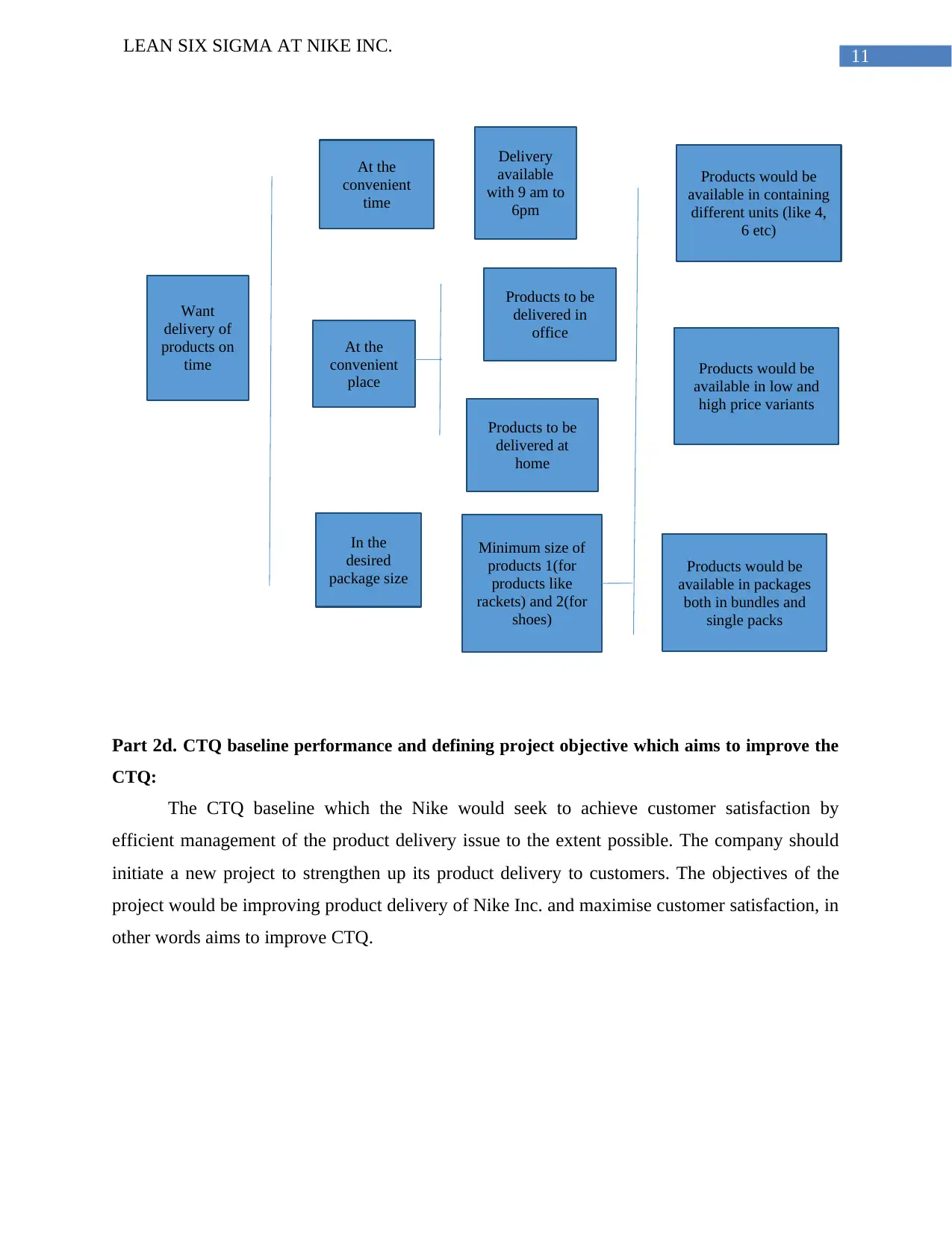
11
LEAN SIX SIGMA AT NIKE INC.
Want
delivery of
products on
time
At the
convenient
time
At the
convenient
place
In the
desired
package size
Delivery
available
with 9 am to
6pm
Products to be
delivered in
office
Products to be
delivered at
home
Minimum size of
products 1(for
products like
rackets) and 2(for
shoes)
Products would be
available in containing
different units (like 4,
6 etc)
Products would be
available in low and
high price variants
Products would be
available in packages
both in bundles and
single packs
Part 2d. CTQ baseline performance and defining project objective which aims to improve the
CTQ:
The CTQ baseline which the Nike would seek to achieve customer satisfaction by
efficient management of the product delivery issue to the extent possible. The company should
initiate a new project to strengthen up its product delivery to customers. The objectives of the
project would be improving product delivery of Nike Inc. and maximise customer satisfaction, in
other words aims to improve CTQ.
LEAN SIX SIGMA AT NIKE INC.
Want
delivery of
products on
time
At the
convenient
time
At the
convenient
place
In the
desired
package size
Delivery
available
with 9 am to
6pm
Products to be
delivered in
office
Products to be
delivered at
home
Minimum size of
products 1(for
products like
rackets) and 2(for
shoes)
Products would be
available in containing
different units (like 4,
6 etc)
Products would be
available in low and
high price variants
Products would be
available in packages
both in bundles and
single packs
Part 2d. CTQ baseline performance and defining project objective which aims to improve the
CTQ:
The CTQ baseline which the Nike would seek to achieve customer satisfaction by
efficient management of the product delivery issue to the extent possible. The company should
initiate a new project to strengthen up its product delivery to customers. The objectives of the
project would be improving product delivery of Nike Inc. and maximise customer satisfaction, in
other words aims to improve CTQ.
⊘ This is a preview!⊘
Do you want full access?
Subscribe today to unlock all pages.

Trusted by 1+ million students worldwide
1 out of 19
Related Documents
Your All-in-One AI-Powered Toolkit for Academic Success.
+13062052269
info@desklib.com
Available 24*7 on WhatsApp / Email
![[object Object]](/_next/static/media/star-bottom.7253800d.svg)
Unlock your academic potential
Copyright © 2020–2025 A2Z Services. All Rights Reserved. Developed and managed by ZUCOL.




